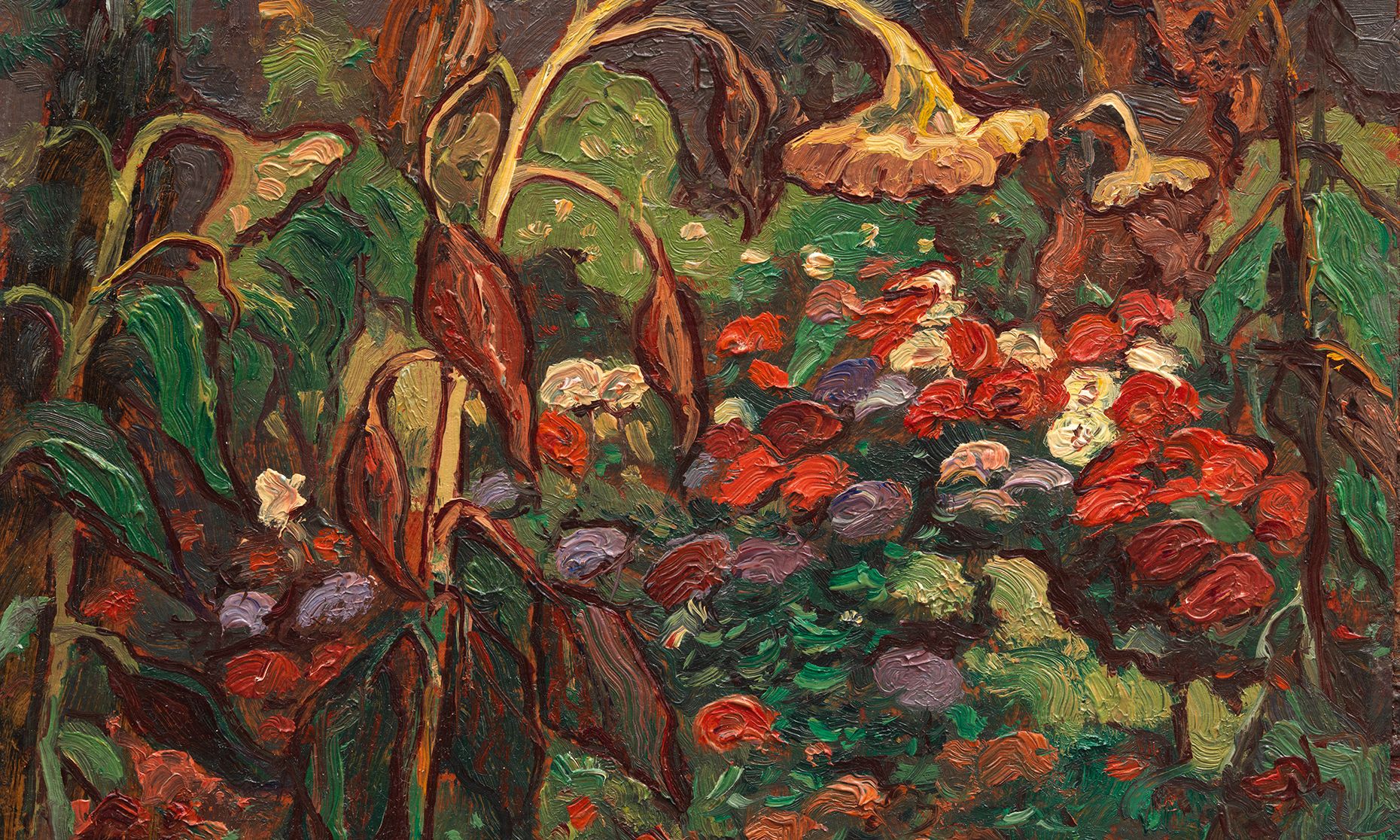An oil sketch after The Tangled Garden, one of ten works originally attributed to J.E.H. MacDonald, acquired by the Vancouver Art Gallery in 2015 Courtesy of Vancouver Art Gallery
Last month, while inaugurating an exhibition devoted to J.E.H. MacDonald, an English-born co-founder of Canada’s famed Group of Seven, the Vancouver Art Gallery (VAG) officially acknowledged that ten oil sketches of MacDonald’s it had acquired in 2015 are in fact forgeries. J.E.H. MacDonald? A Tangled Garden (until 12 May) foregrounds the forensic methodology used to determine whether works are “correct”, as well as showcasing the VAG’s Group of Seven collection and meditating on the meaning and value of authenticity.
The exhibition begins with a display of dozens of paintings by the Group of Seven, the Canadian group of early-20th-century artists known for works that helped the young, vast country build a national identity. The story of the forged MacDonald sketches’ discovery is told in an adjacent gallery via a 13-minute video in which the former senior curator Ian Thom, who brought the works into the gallery’s collection, explains publicly for the first time what happened. “When it first started, I thought this is one of the great experiences of my life,” says Thom, who retired from the gallery in 2018. “Then it just got worse and worse and worse.”
Thom explains that the works came to his attention via the dealer Janet McNaught of Arctic Experience McNaught Gallery in Hamilton, Ontario. The Merkur family, friends of the MacDonalds, invited Thom to examine a large collection of works and make a selection for donation to the VAG. From that collection he chose the ten works in question, purportedly by MacDonald.
The story of the works’ provenance is told in a framed press release from the museum dated 13 January 2015, announcing the gift—a story then-VAG director Kathleen Bartels described as “incredible”. The sketches are touted as “studies for MacDonald’s most iconic large-scale paintings”, which were in important collections across the country, including at the Art Gallery of Ontario and the National Gallery of Canada. The 2015 announcement explained that the sketches were buried in the backyard of the MacDonalds’ home near Toronto in the 1930s by J.E.H. and his son Thoreau, “in order to preserve and safeguard the works” before J.E.H. travelled to Barbados for health reasons. Wrapped in cellophane and tar paper, they purportedly remained buried for more than 40 years.
According to Globe and Mail reporter Marsha Lederman, who broke the story of the forgeries in December and has been following the saga for years, the story told to the VAG was that the works were unearthed in 1974, for the benefit of Toronto developer and collector Max Merkur. He was advised by another Group of Seven member, A.J. Casson, to buy the sketches because they would one day be valuable. When Merkur’s widow Reta died in 2012, their son Ephraim discovered the sketches in the basement of the family home and his brother Melvin made the donation to the VAG in 2015 in consultation with Thom and McNaught.
But when the donated works went on view in 2015, there was immediate outcry from art historians that the sketches were, in fact, sketchy. The exhibition closed after one day and an investigation was launched. The museum brought in Charles Hill, the former curator of Canadian art at the National Gallery of Canada, who recounts in the video that the 40-year burial story “raised a lot of alarm bells” as the sketches had never been referenced in studies of MacDonald’s work and were in pristine condition.
The new show attests that there were other red flags about the drawings stemming from stylistic issues including unusually hot colour palettes and discrepancies between the purported sketches and the final paintings that suggested the former might be copies of the latter. The late Dan C. Purdy, retired chief scientist of the forensic laboratories at the Royal Canadian Mounted Police, was consulted and concluded that all but one of the signatures on the sketches were fake.
Finally, the scientist Kate Helwig of the Canadian Conservation Institute (CCI), an agency of the Department of Canadian Heritage that performs scientific examinations for museums and galleries, analysed the sketches. She noted inconsistencies in the size, thickness and colour of the board used by MacDonald at that stage in his career; a pigment analysis ultimately provided the smoking gun. The CCI analysis found pigments not available during MacDonald’s lifetime in eight of the ten sketches; the other two contained pigments that were not yet available at the time the sketches were purportedly made.
The new show demonstrates the VAG’s commitment to “transparency”, the museum’s chief executive and executive director Anthony Kiendl said at the opening. But many have questioned why it took nearly nine years for the truth about the supposed MacDonald sketches to be made public. Bartels and Thom have declined to address this in the media. When Kiendl took over after Bartels’s departure in 2019, he had to grapple with staffing issues, fundraising for a substantial new building and then the pandemic; he handed the MacDonald file to Richard Hill when he joined as a curator of Canadian art in 2021.
The VAG team may have found inspiration in a 2021 show at the Art Gallery of Hamilton, Ontario, that invited viewers to decide for themselves whether pieces from its collection of works by Tom Thomson were authentic. And, as revealed in Jon S. Dellandrea’s 2022 book The Great Canadian Art Fraud Case—which chronicles the unravelling of a Thomson forgery ring in 1962, when a police investigation was initiated by the National Gallery of Canada and Casson was enlisted to assist—the only thing as quintessentially Canadian as the Group of Seven may be art forgery.

